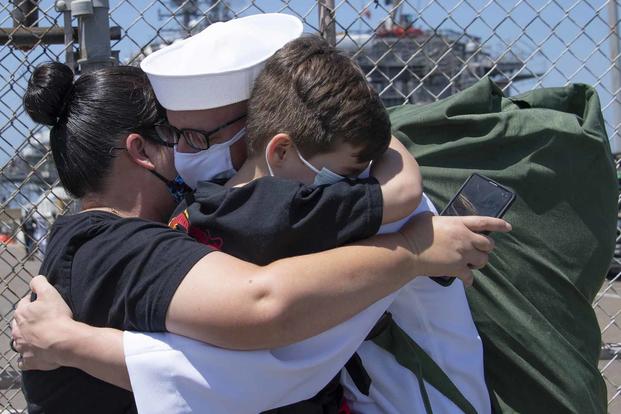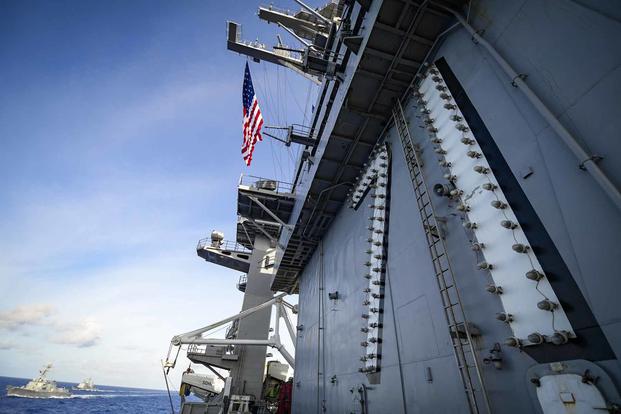The carrier Theodore Roosevelt arrived in San Diego on Thursday, but it's returning without two crew members who died during the deployment and the original commanding officer.
Read Next: Soldier Makes History as First Woman to Join the Green Berets
The crew has seen a challenging six-month deployment, fraught with sickness and leadership upheavals since it deployed to the Asia-Pacific region in January. Two other ships with the carrier strike group -- the destroyer Russell and guided-missile cruiser Bunker Hill -- returned to California on Wednesday, officials with Third Fleet announced.

The Roosevelt's crew lost two sailors during the deployment. Aviation Electronics Technician Chief Petty Officer Justin Calderone, assigned to Strike Fighter Squadron 146, died last week following a medical emergency. In April, Aviation Ordnanceman Chief Petty Officer Charles Robert Thacker Jr. died of complications due to COVID-19, the illness caused by the coronavirus.
Weeks earlier, the ship's former commanding officer, Capt. Brett Crozier, was relieved of command over his handling of an emailed warning about the carrier's growing health crisis as COVID-19 cases began to spread rapidly. Crozier was one of the 1,273 crew members to contract the virus in the Navy’s largest outbreak to date.
Crozier's relief was followed up with an unplanned visit from then-acting Navy Secretary Thomas Modly, who flew nearly 8,000 miles from Washington, D.C., to Guam, where the carrier was sidelined for about two months as the crew was evacuated and isolated. Modly, who had fired Crozier, slammed the captain's decision to send an emailed warning about the coronavirus cases on the Roosevelt, calling him "too naïve or too stupid" to serve as their commanding officer.
The speech was recorded and obtained by media outlets, including Military.com. Modly faced backlash over his speech and the decision to fly across the globe to deliver it. He stepped down April 7, leaving the Navy secretary position suddenly vacant for the second time in six months.
The Roosevelt spent about one-third of its deployment docked in Guam. Much of the crew was moved into hotels and other facilities as the ship was disinfected, but the coronavirus spread rampantly among its personnel, eventually infecting about a quarter of the sailors on the ship.
The crew headed back out to sea in May. About a month later, the Navy's top leaders revealed the findings of a new investigation into Crozier's firing, announcing that they would uphold the decision and weigh the planned promotion of a one-star over what they called questionable decisions as COVID-19 cases began to mount.
That was after Chief of Naval Operations Adm. Mike Gilday recommended that Crozier be reinstated as the Roosevelt's commanding officer. When pressed to address his reversal, Gilday said his initial recommendation was based only on a "narrowly scoped investigation" that examined Crozier's email warning.
"I was tasked to take a look at those facts against then-Acting Secretary Modly's justification for relieving him," Gilday told reporters, "and I did not feel that the ... facts supported the justification."
"It is because of what he didn't do that I have chosen not to reinstate him," Gilday said, adding that Crozier was slow to put in place measures to keep the crew safe during the outbreak and released some members who'd been quarantined too quickly.
In June, the Roosevelt saw another crisis when an F/A-18F Super Hornet crashed into the Philippine Sea during a routine training flight. Both the pilot and weapon systems officer safely ejected and were recovered by an MH-60S helicopter.
Hundreds of members of the Roosevelt's crew opted to participate in a study between the Navy and Centers for Disease Control and Prevention looking at how coronavirus affects young people living in close quarters. The study found about a third of participants who'd tested positive for COVID-19 developed antibodies for the illness.
-- Gina Harkins can be reached at gina.harkins@military.com. Follow her on Twitter @ginaaharkins.
Related: Navy Won't Reinstate Crozier, Holds 1-Star's Promotion Over Poor Decision-Making













